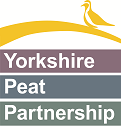Picture yourself high up on a hill, you look to the horizon to see yet more distant hills. The land is open. The horizon cuts sharply, separating hill top and sky. Looking down, you see patches of rich, red mounds, and pools full of vibrant, green moss. All around the pool, strange red grasses with large, white, fluffy seeds dance in the wind and alien looking plants with sticky buds trap unsuspecting insects. The ground beneath you is unsteady, you feel it quake with every footfall. Here on the rain soaked hills, where the land meets the sky, is blanket bog; a land of moss.
A land of moss
Sphagnum pool on Stake Moss filmed from the air
Bog formation
The moss in question is sphagnum, the bog builder. Soaking up rain and mist in its branching leaves, millimetre by millimetre, year by year, the sphagnum grows. Evolved to thrive in harsh environments, the moss releases acid, ensuring other plants find it difficult to grow. Over millennia, metres of saturated peat build up. Walking on a bog is walking on water, your feet only held from sinking by the interweaving structures of the mossy remains below. This wetland environment, naturally acidic and waterlogged, drapes over our uplands like a green blanket.
Yorkshire’s rainforests
Harsh environments can lead to intense competition where species evolve to occupy very specific niches. There aren’t many sources of nutrients in a bog, so plants have made amazing adaptations to survive. The most spectacular is the sundew, a carnivorous plant, using sticky, sugary sap on the end of long hairs to attract, trap and digest insects.
Amazing diversity and microclimates develop in bogs. Some sphagnum species such as the red capilifolium prefer things marginally drier and can form big hummocks extending above the water table. Cuspidatum is a pool dwelling moss, preferring to be submerged in water. Appearing solid, green carpets of sphagnum have caused many a wet foot and lost boot for the unwary walker.
When viewed from above the landscape seems flat, but crouch down and you will see that a preference for different heights has created an undulating landscape of hummocks and hollows. Mosses, lichens, grasses; the colours and shapes play out like a miniature worlds - Yorkshire’s rainforests.
Wetlands, the cradle of life
Bogs are wetlands deriving their water only from the sky either as rain, mist or snow. Wetlands around the world are the nurseries of life. On the blanket bogs of Yorkshire, bright sphagnum pools provide a haven for insects where spectacular, emerald dragonflies hawk for prey. What often seem like desolate landscapes can provide amazing sustenance. The great migratory birds we look forward to seeing along the coasts or open fields begin their life in the uplands with the rich bounty of insects feeding hungry chicks.
Exploitation
All over the world however, peat bogs have been exploited and dug up so the peat can be used to fuel fires or in horticulture. These damaging practices are accelerating climate change, so remember to buy only peat free compost. Ensuring that our blanket bogs remain covered in sphagnum creates a rough surface, slowing the flow of rain hitting our uplands and reducing flooding in our towns and cities.






